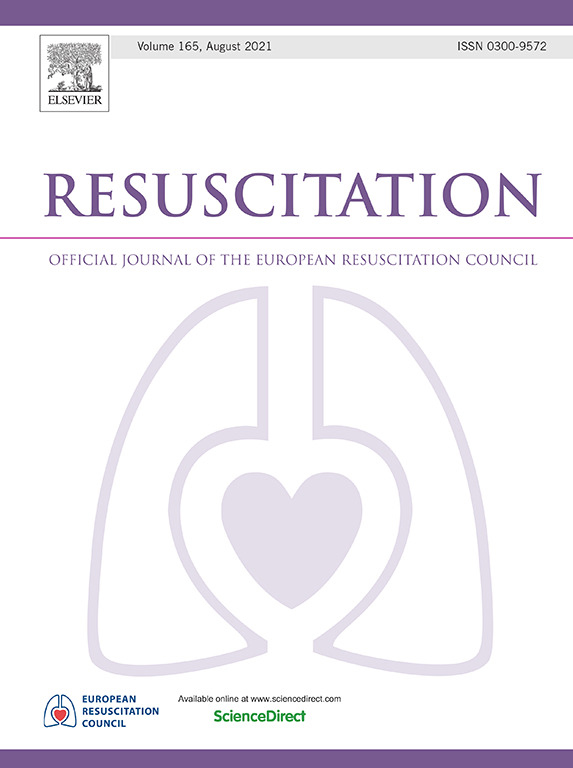Prehospital management of supraventricular tachycardia: a multicentre study of current practices with a subgroup propensity score-based comparison of adenosine and electrical cardioversion in unstable patients
IF 6.5
1区 医学
Q1 CRITICAL CARE MEDICINE
引用次数: 0
Abstract
Background
Supraventricular tachycardia (SVT) is a common prehospital arrhythmia that can cause life-threatening instability. Adenosine is the first-line treatment for stable SVT, but guidelines differ for unstable cases with hypotension, syncope, myocardial ischaemia, or severe heart failure. The European Resuscitation Council recommends electrical cardioversion (ECV), while the American Heart Association allows for an adenosine trial. This multicentre observational retrospective study evaluated global prehospital management strategies for SVT, subsequently focusing on adenosine vs ECV in unstable patients.
Methods
Data from 2019 to 2024 were collected from three Italian physician-staffed Emergency Medical Services. Primary outcome was the rate of successful cardioversion; secondary outcomes included the presence of life-threatening complications following cardioversion. Finally, the diagnostic accuracy of available ECG traces was evaluated. Propensity score-weighted analysis was employed to control for potential cofounding variables.
Results
Among 1234 SVT events, 819 (66.3 %) underwent prehospital cardioversion. Of these, 763 (93.2 %) received adenosine and 56 (6.8 %) underwent ECV. Unweighted cardioversion success rates were 80.1 % for adenosine and 83.9 % for ECV. In unstable patients, ECV had a weighted odds ratio of 2.41 (95 % CI: 1.01–7.14) for successful conversion. ECV was associated with more frequent sedative use compared to adenosine. No complications were observed in either groups. ECG diagnostic accuracy was 90.7 %, with dangerous misdiagnosis, such as ventricular tachycardia, occurring in fewer than 2 % of available ECG readings.
Conclusions
In patients with prehospital SVT, adenosine is the preferred cardioversion strategy. In unstable cases, adenosine may be a safe first-line attempt before ECV, potentially reducing sedation-related risks.
Trial registration
ClinicalTrials.gov Identifier: NCT06077799.
室上性心动过速的院前处理:一项基于亚组倾向评分比较不稳定患者腺苷和电性心律失常的多中心研究
背景:室上性心动过速(SVT)是一种常见的院前心律失常,可导致危及生命的不稳定性。腺苷是稳定SVT的一线治疗,但对于低血压、晕厥、心肌缺血或严重心力衰竭的不稳定病例,指南有所不同。欧洲复苏委员会推荐电复苏术(ECV),而美国心脏协会允许腺苷试验。这项多中心观察性回顾性研究评估了SVT的全球院前管理策略,随后关注不稳定患者的腺苷与ECV。方法:收集2019年至2024年意大利三家由医生组成的紧急医疗服务机构的数据。主要观察指标为心律转复成功率;次要结局包括心律转复后出现危及生命的并发症。最后,对可用心电迹线的诊断准确性进行了评价。倾向得分加权分析用于控制潜在的共同发现变量。结果:在1234例SVT事件中,819例(66.3%)进行了院前转复。其中763例(93.2%)接受了腺苷治疗,56例(6.8%)接受了ECV治疗。未加权的复心成功率腺苷组为80.1%,ECV组为83.9%。在不稳定患者中,ECV成功转换的加权优势比为2.41 (95% CI: 1.01-7.14)。与腺苷相比,ECV与更频繁的镇静剂使用相关。两组均无并发症发生。心电图诊断准确率为90.7%,危险的误诊,如室性心动过速,发生在不到2%的可用心电图读数。结论:院前SVT患者,腺苷是首选的心律转复策略。在不稳定的病例中,腺苷可能是ECV前安全的一线尝试,可能降低镇静相关风险。试验注册:ClinicalTrials.gov标识符:NCT06077799。
本文章由计算机程序翻译,如有差异,请以英文原文为准。
求助全文
约1分钟内获得全文
求助全文
来源期刊

Resuscitation
医学-急救医学
CiteScore
12.00
自引率
18.50%
发文量
556
审稿时长
21 days
期刊介绍:
Resuscitation is a monthly international and interdisciplinary medical journal. The papers published deal with the aetiology, pathophysiology and prevention of cardiac arrest, resuscitation training, clinical resuscitation, and experimental resuscitation research, although papers relating to animal studies will be published only if they are of exceptional interest and related directly to clinical cardiopulmonary resuscitation. Papers relating to trauma are published occasionally but the majority of these concern traumatic cardiac arrest.
 求助内容:
求助内容: 应助结果提醒方式:
应助结果提醒方式:


